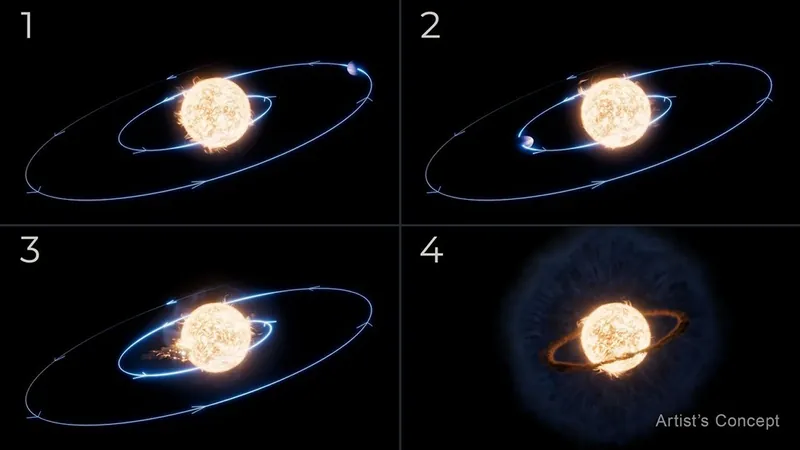
Astronomical Revelations: The Shocking Truth Behind a Planet Devoured by Its Star!
2025-04-15
Author: Nur
In a groundbreaking discovery from 2020, astronomers witnessed a star seemingly swallowing one of its orbiting planets. However, new insights from NASA's James Webb Space Telescope (JWST) illuminate a much stranger tale about the planet's tragic fate.
Recent evidence reveals that, instead of the star expanding and engulfing the planet, it actively pulled the planet closer until it was ultimately consumed. The astounding findings were detailed in a paper published in The Astrophysical Journal on April 10.
A Rare Celestial Event: ZTF SLRN-2020
Dubbed ZTF SLRN-2020, this extraordinary event features a Jupiter-sized planet circling a star located an astonishing 12,000 light-years from Earth. Astronomers first noticed a brilliant flash of optical light, signaling the moment the star devoured the planet, leaving behind a cloud of cosmic dust.
Ryan Lau, the study's lead author and assistant astronomer from the National Science Foundation National Optical-Infrared Astronomy Research Laboratory, described this event as "likely the first planetary engulfment captured in real-time." A rare occurrence indeed!
Misconceptions About Stellar Evolution
Initially, scientists believed the star was akin to our sun and merely undergoing its natural life cycle. According to a previous study in 2023, it was thought that the star had entered its final phase as a red giant, a stage when stars balloon as they exhaust their hydrogen fuel—a fate that awaits our sun in about 5 billion years.
However, JWST's observations present a radically different scenario. The data revealed that the star lacked the expected infrared brightness associated with red giant stars, indicating it wasn't swelling as previously thought.
Close Encounters of a Gravitational Kind
The doomed planet positioned itself frighteningly close to its host star—closer than Mercury orbits our sun. The research team suspects that gravitational forces between the star and the planet triggered a phenomenon known as orbital decay, where the planet spiraled inward due to powerful tidal interactions.
This entire dramatic descent likely unfolded within just a few months. As the planet made contact with the star's surface, it faced intense drag forces that pulled it into the star's core, resulting in its complete engulfment. The star then expelled planetary debris, creating the brilliant light event first observed in 2020.
An Exciting Future for Astronomical Discoveries
Spotting such events can be challenging due to their faint light signatures. However, Lau expressed optimism that with the upcoming Vera C. Rubin Observatory, detecting these kinds of celestial phenomena will become much easier.
"We should be finding way more of these in the future!" Lau enthused. And indeed, the cosmos continues to surprise us with its mysteries!

 Brasil (PT)
Brasil (PT)
 Canada (EN)
Canada (EN)
 Chile (ES)
Chile (ES)
 Česko (CS)
Česko (CS)
 대한민국 (KO)
대한민국 (KO)
 España (ES)
España (ES)
 France (FR)
France (FR)
 Hong Kong (EN)
Hong Kong (EN)
 Italia (IT)
Italia (IT)
 日本 (JA)
日本 (JA)
 Magyarország (HU)
Magyarország (HU)
 Norge (NO)
Norge (NO)
 Polska (PL)
Polska (PL)
 Schweiz (DE)
Schweiz (DE)
 Singapore (EN)
Singapore (EN)
 Sverige (SV)
Sverige (SV)
 Suomi (FI)
Suomi (FI)
 Türkiye (TR)
Türkiye (TR)
 الإمارات العربية المتحدة (AR)
الإمارات العربية المتحدة (AR)